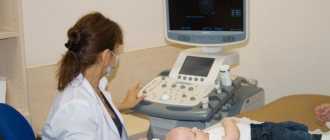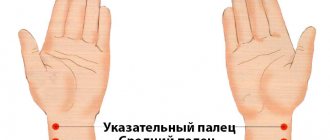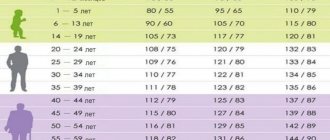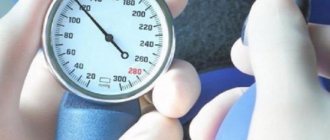Blood pressure (BP) should be understood as the force with which blood presses on the vascular walls. Mean arterial pressure is the average blood pressure of a person, that is, the average blood pressure during one cardiac cycle. It is measured to understand how well all the organs of the body function, how they are saturated with blood and essential nutrients.
Mean arterial pressure is the pressure during all phases of the cardiac cycle. Its normal value ranges from 70-110 mmHg.
Standard calculation formula
Now that we have learned how to calculate diastolic and systolic pressure, we can begin to determine mean arterial pressure.
There is a standard, time-tested formula for this. Average BP = (2*Diastole BP + Systole BP)/3
That is, if your diastolic pressure is 90 mmHg, and your systolic pressure is 125 mmHg, then:
Average BP = (2*90+125)/3 = 101.67 mmHg
If we round, it turns out that the average pressure of the person in the example will be 102 mmHg.
Therapy for deviations in indicators
Adjusting your diet, moderate physical activity, and drug therapy will help return your blood pressure to normal values.
The diet is always agreed with the attending physician, because allergic reactions and chronic diseases can cause blood pressure imbalance.
Elevated systolic pressure readings are corrected by a healthy diet with a high content of vegetables, fruits, white meat, fish, dairy products, green and red tea in the menu.
Dishes made from complex carbohydrates will help increase diastolic pressure: durum pasta, cereals, whole grain bread. Physical activity should be dosed, with the exception of professional sports training, where the instructor monitors the athlete’s health indicators
Prolonged static postures lead to a decrease in blood pressure, so it is important to include dynamic breaks during the working day.
Medicines are prescribed from a minimum dose, and if necessary, the course is repeated with an increase or replacement of the drug. Therapy is carried out by a cardiologist or therapist, the choice depends on the severity and extent of the disease.
Calculation formulas
First formula: (2 ×DBP +SBP) ÷ 3
Diastolic blood pressure is multiplied by 2, systolic blood pressure is added, and the result is divided by 3.
With readings of 120/80, the calculations look like this: (2 × 80 + 120) ÷ 3 = 93 mmHg. Art.
Second formula: (SBP – DBP) ÷ 3 + DBP
- What do upper and lower blood pressure mean?
Diastolic blood pressure is subtracted from systolic blood pressure, the difference is divided by 3, and diastolic blood pressure is added to the result.
Calculation based on indicators 120/80: (120 – 80) ÷ 3 + 80 = 93 mm Hg. Art.
Both calculation options give identical and accurate results.
The average pressure can be approximately calculated using the Wetzler-Boger formula:
(0.42 × SBP) + (0.58 × DBP)
See also Diabetes mellitus: what pills you can take for blood pressure
The upper pressure is multiplied by a factor of 0.42; lower - by 0.58. The works are added up.
Calculation using the example of blood pressure 120/80: (120 × 0.42) + (80 × 0.58) = 96.8 mm Hg. st
The result of calculations using this formula is less accurate than in the first two options.
- Medicines that lower blood pressure
In hospitals, a person’s average pressure is calculated using the formula: CO × OPSS.
CO - cardiac output is the amount of blood that the heart pumps into the arteries in one beat. TPR - total peripheral vascular resistance. These indicators are measured using special medical equipment.
Important! Often, the difference between upper and lower blood pressure is taken as mean arterial pressure. This is actually pulse pressure (PP). It is called an indicator of the biological age of blood vessels. PP is determined as follows: the lower blood pressure is subtracted from the upper blood pressure. The result should be within 30-45 mmHg. Art. If the indicator differs from normal, an examination should be carried out and the reason that causes the deviations should be determined.
Concomitant pathologies
In addition to age, a systematic increase in pressure is provoked by metabolic disorders, kidney disease, bad habits, etc. Smoking provokes a narrowing of small blood vessels, which in the long term causes a decrease in the lumen of large arteries and, as a result, hypertension. When kidney function is impaired, the hormone aldosterone is produced, which also leads to an increase in blood pressure. There is a risk of hypertension in diabetics, whose blood vessels are especially prone to deposits on the inner walls. Timely detection and prevention of major diseases will allow you to maintain normal blood pressure and live an active life.
Normal blood pressure
Each person's working blood pressure is individual! With age, it may increase slightly, but this is not considered a pathology.
- Blood pressure: deviations from the norm, measurement methods, treatment and prevention of diseases
According to generally accepted standards, human blood pressure is divided into:
- optimal – 120/80 mm Hg. Art.;
- normal – 130/85 mm Hg. Art.;
- elevated – 135-139/85-89 mm Hg. Art.;
- high – more than 140/90 mm Hg. Art.
| State | Pressure norm |
| Needs attention | ≥ 140/90 |
| Medical attention required | ≥ 150/95 |
| Requires hospitalization and monitoring | ≥ 170/100 |
With physical activity, blood pressure increases due to the needs of the body. Changes by 20 mm Hg. Art. in one direction or another is considered normal, but these data are not used in calculating SBP.
That is why you need to measure blood pressure only after 5 minutes of rest.
Doctors also recommend avoiding smoking and caffeine before the test, as they may affect the results.
How to measure blood pressure correctly
To accurately measure your blood pressure, you need to choose a high-quality and convenient tonometer.
They come in several types:
- manual or mechanical;
- semi-automatic;
- automatic.
Conventional hand-held measuring instruments, which are often used in hospitals, require certain skills. But they are cheaper than their semi-automatic and automatic counterparts.
The operating principle of all devices is the same! A cuff is placed on the forearm or wrist and filled with air to create the necessary pressure on the artery. The air is then gradually released.
However, to measure blood pressure using the Korotkoff method using a hand-held tonometer, you must use a stethoscope.
It will allow you to catch the noise that occurs in the artery during the change. In automatic and semi-automatic blood pressure monitors, the pulse and pressure are recorded by the device itself. They differ from each other only in that in the first case the air is pumped into the cuff by a motor, and in the second by a hand bulb.
The results obtained after diagnosis by these devices are usually displayed in the form of three numbers. The first is systolic pressure, the second is diastolic, and the third is pulse.
To accurately measure blood pressure, you must follow several rules:
- It should always be measured at the same time! It is better before eating and taking medications that may affect performance.
- Before the procedure, you need to spend some time at rest. It is best to sit comfortably in a chair and put your hands on the table.
- Before starting measurements, be sure to read the instructions in order to use the device correctly.
- Blood pressure should be re-measured no earlier than after 30 seconds so that the pulse has time to return to normal.
- It is necessary to place the cuff, both in the case of forearm meters and those that are fixed on the wrist, at the level of the heart. This way you can avoid errors.
If there are no instructions, then you need to remember that in forearm tonometers the cuff must be placed slightly above the elbow. When using a device with a built-in microphone, the membrane should be on the inside of the bend where the artery passes.
Manual and semi-automatic devices require a certain pressure in the cuff. It is necessary to pump up the air with the bulb to a reading of 30 mm Hg. Art. to the expected upper value. This is not required on automatic models.
Indications for use
The procedure is prescribed to patients who complain of:
- fatigue;
- headaches, dizziness;
- decreased vision, spots before the eyes;
- noise or ringing in the ears, stuffy ears.
ABPM can also be prescribed to a person who has no unpleasant symptoms, but when the doctor measures the blood pressure, it is elevated. The reason for this may be the “white coat” phenomenon: this is an individual characteristic that is expressed in a specific psychological reaction to doctors. A person with the “white coat” phenomenon begins to worry excessively during any medical procedures, so his blood pressure and heart rate increase. Measuring blood pressure and heart rate using daily monitoring allows us to exclude the influence of this phenomenon on the diagnosis.
Prevention and recommendations
To keep blood pressure within normal limits, you should follow the recommendations of doctors:
- Introduce a lot of fresh vegetables and fruits into your diet. They contain a large amount of vitamins and beneficial elements necessary for normal heart function. Complex carbohydrates will relieve the heart muscle.
- Eat more fish and protein.
- Minimize your consumption of coffee and black tea as they contain high amounts of caffeine.
- Play sports, walk more in the fresh air.
- Avoid sweets, as they lead to extra pounds and the development of pancreatic diseases.
- Rest after a hard day should not be neglected; it is important that the body recovers from physical and mental stress.
- Consume as many fermented milk products as possible. They help not only improve intestinal function, but also have a beneficial effect on the functioning of the heart.
To prevent a heart attack, doctors prescribe special medications. They help normalize blood pressure, improve blood circulation, strengthen blood vessels and improve the general condition of the patient. Medicines are prescribed only by a specialist. Self-medication is unacceptable.
Every person should know how to find average pressure. His indicators indicate his state of health. Deviations from the norm, as a rule, indicate the development of pathology. In this case, you should consult a doctor to undergo an examination and determine the reason for the change in values. If a disease is detected, adequate treatment should be started immediately.
Doctors recommend
For effective treatment of hypertension at home, experts advise Phytolife
. This is a unique tool:
- Normalizes blood pressure
- Prevents the development of atherosclerosis
- Reduces sugar and cholesterol levels
- Eliminates the causes of hypertension and prolongs life
- Suitable for adults and children
- Has no contraindications
Manufacturers have received all the necessary licenses and quality certificates both in Russia and in neighboring countries.
We offer a discount to readers of our site!
Do you still think that it is impossible to cure hypertension?
Hypertension, unfortunately, always leads to heart attack or stroke and death. For many years, we only stopped the symptoms of the disease, namely high blood pressure.
Only constant use of antihypertensive drugs could allow a person to live.
Now hypertension can be CURED; this is available to every resident of the Russian Federation.
Was the article helpful?
Rate the material on a five-point scale!
If you have any questions or want to share your opinion or experience, write a comment below.











